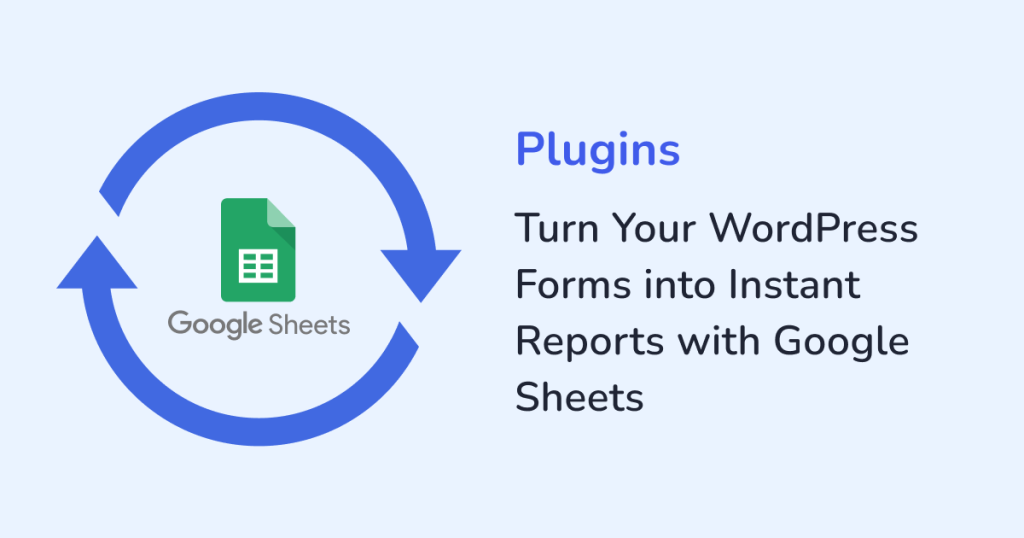
Collecting data through WordPress forms is easy. But, making sense of it can be challenging. You might be dealing with:
- Tracking leads
- Customer inquiries
- Volunteer sign-ups
- Product feedback
Manually exporting CSV files and cleaning them up wastes time. It also introduces errors and slows decision-making. WPSyncSheets lets you sync all your WordPress form submissions directly into Google Sheets where you can turn raw data into actionable insights, using:
- Instant filters
- Charts
- Dashboards
This allows your team to work smarter, faster, and collaboratively. In this article, we’ll explore how to turn your WordPress forms into instant reports with Google Sheet.
Why Manual Reporting Falls Short?
Many businesses still rely on exporting form submissions as CSV files, then importing them into spreadsheets for analysis. This approach has serious drawbacks. Some of them include:
- Time-consuming: Handling the data manually during export and formatting can take hours. Automating these tasks,
- ensures efficiency
- saves time
- allows teams to focus on higher-value work
- Error-prone: The common errors during manual process include:
- Copy-paste mistakes
- Duplicates
- Missing entries
- Delayed insights: Data often becomes outdated by the time it’s fully prepared. Such delays hinder the ability to:
- respond quickly
- make informed decisions
- Limited collaboration: Only one person can manage the CSV at a time. This means, other team members have to wait for updates.
If these challenges sound familiar, it’s time to adopt a live and automated system that:
- Keeps your team aligned
- Eliminates hours of manual work
- Ensures data is up-to-date
Why Do Google Sheets Work Better Than Manual Reports?
By syncing WordPress forms into Google Sheets using WPSyncSheets, you get a dynamic, real-time reporting system. Here’s why it works in the real-world.
1. Familiar and Easy to Use
Almost everyone knows how to use Google Sheets, making onboarding painless. The team can start using the synced form data right away, this helps in:
- Reducing the learning curve.
- Letting your team focus on action.
- Analyzing and acting on the information instead of figuring out the tool itself.
Example:
A boutique eCommerce store collects hundreds of inquiries via Contact Form 7 weekly. Before WPSyncSheets, the manager spent hours exporting CSVs and cleaning the data. Now, with WPSyncSheets For Contact Form 7, submissions flow automatically into a Sheet where marketing and support teams can:
- Filter requests by product
- Sort inquiries by region
- Prioritize by urgency
Therefore, this simple setup saves them hours and ensures no customer request gets overlooked.
2. Cost-Effective
No need for expensive reporting or CRM software. Google Sheets is free, and WPSyncSheets eliminates the cost of additional tools. Together, they let you:
- Build custom reports
- Create real-time dashboards
- Generate insights from live data
With this integration, you don’t have to pay for extra software or licenses.
Example:
A nonprofit organization tracks volunteer sign-ups, donations, and event registrations. With WPSyncSheets, all form submissions sync automatically to Google Sheets. As a result, without paying for extra software, the coordinators can:
- generate reports
- assign tasks
- monitor progress
3. Real-Time Data
Forget outdated CSV exports. WPSyncSheets pushes new submissions instantly into Sheets. So, your team always sees the most up-to-date information.
Example:
A SaaS company uses Elementor forms to gather:
- feature requests
- bug reports
Previously, product managers only received updates after exporting CSV files. With WPSyncSheets For Elementor, submissions appear instantly and enables the team to:
- prioritize urgent issues
- respond faster to user needs
4. Customizable Dashboards
With Google Sheets, you can build pivot tables, charts, and filtered views tailored to your workflow.
Example:
A marketing agency collects leads from multiple client forms. With WPSyncSheets, submissions from all forms appear in a single sheet. The team uses filters and pivot tables to track leads by:
- Campaign
- Region
- Conversion status
This allows them to optimize ad spend and campaigns efficiently.
5. Simplified Team Collaboration
Sheets can be shared securely, giving team members real-time access without exposing WordPress backend.
Example:
A growing online store has separate teams for sales, support, and fulfillment. WPSyncSheets For WPForms syncs customer queries from WPForms into Sheets, where:
- Support team updates statuses
- Sales team monitors new leads
- Managers track performance metrics
Everyone works on the same live data, eliminating confusion and duplicated efforts.
Key Benefits of Using WPSyncSheets
- Save time: By automating sync, teams can spend less time on managing spreadsheets. This helps to focus on:
- analyzing and acting on data
- making faster and data-driven decisions
- Reduce errors: Manual copy-paste mistakes are a thing of the past. Every submission is recorded accurately in real-time.
- Gain insights faster: With WPSyncSheets, you can do the the following things instantly:
- Spot trends by applying filters
- Prioritize tasks by sorting data
- Identify opportunities faster by creating charts
- Collaborate efficiently: Share the Google Sheets with your clients and teammates. Everyone sees live updates without needing WordPress access.
- Scale effortlessly: As form submissions grow, your Google Sheet scales with you. This avoids the use of any expensive BI software or complex dashboards.
Therefore, by pairing Google Sheets with WPSyncSheets, you get:
- Live data
- Actionable insights
- A system that scales with your business
How to Set Up Instant Reports in Google Sheets?
Here’s a simple guide to get your WordPress forms syncing with Sheets:
- Install the WPSyncSheets plugin
Choose the version compatible with your form plugin: - Connect Your Google Account
Authenticate securely to allow WPSyncSheets to sync submissions into Google Sheets. - Create a Sheet for Reports
Set up columns for key data points, including:- Name
- Issue
- Status
- Date Submitted
- Map Form Fields
In WPSyncSheets settings, you can map each WordPress form field to the corresponding Google Sheet column. - Test and Go Live
Now, you can submit a sample form entry and confirm it appears in Sheets. Once verified, the system runs automatically in the background. - Analyze and Filter
In Google Sheets, you can use the following:- Filters
- Pivot tables
- Charts
These options will turn the WordPress form submissions into actionable insights, with which you can track the following thing effortlessly:
- Trends
- Team performance
- Customer feedback
Final Thoughts
Manually handling WordPress form submissions is both time-consuming and prone to errors. WPSyncSheets transforms Google Sheets into a real-time reporting hub that is:
- Easy to use
- Collaborative
- Cost-effective
Whether you run an online store, or a SaaS company, this setup allows you to:
- Turn raw form submissions into actionable reports
- Reduce manual work and errors
- Collaborate with your team in real-time
- Scale effortlessly as your business grows
So, stop wasting time on CSV exports and complicated dashboards. Make Google Sheets your live reporting solution with WPSyncSheets today.
FAQs
1. Can I sync multiple WordPress forms into one Google Sheet?
Yes. WPSyncSheets supports syncing multiple forms into a single Sheet or separate Sheets as needed. WPSyncSheets supports the following forms:
- WPForms
- Elementor
- Gravity Forms
- Contact Form 7
2. Do I need coding skills to use WPSyncSheets?
No, the plugin is beginner-friendly and works without coding.
3. Can Google Sheets replace a traditional reporting dashboard?
For most small to medium-sized teams, yes. Google Sheets paired with WPSyncSheets provides:
- Real-time reporting
- Pivot tables
- Charts
- Collaborative features
All of these help in eliminating the need for complex BI software.
4. Is my data secure when synced to Google Sheets?
Yes. Data is transferred securely via Google’s API, and sharing permissions can be managed directly in Google Sheets.







